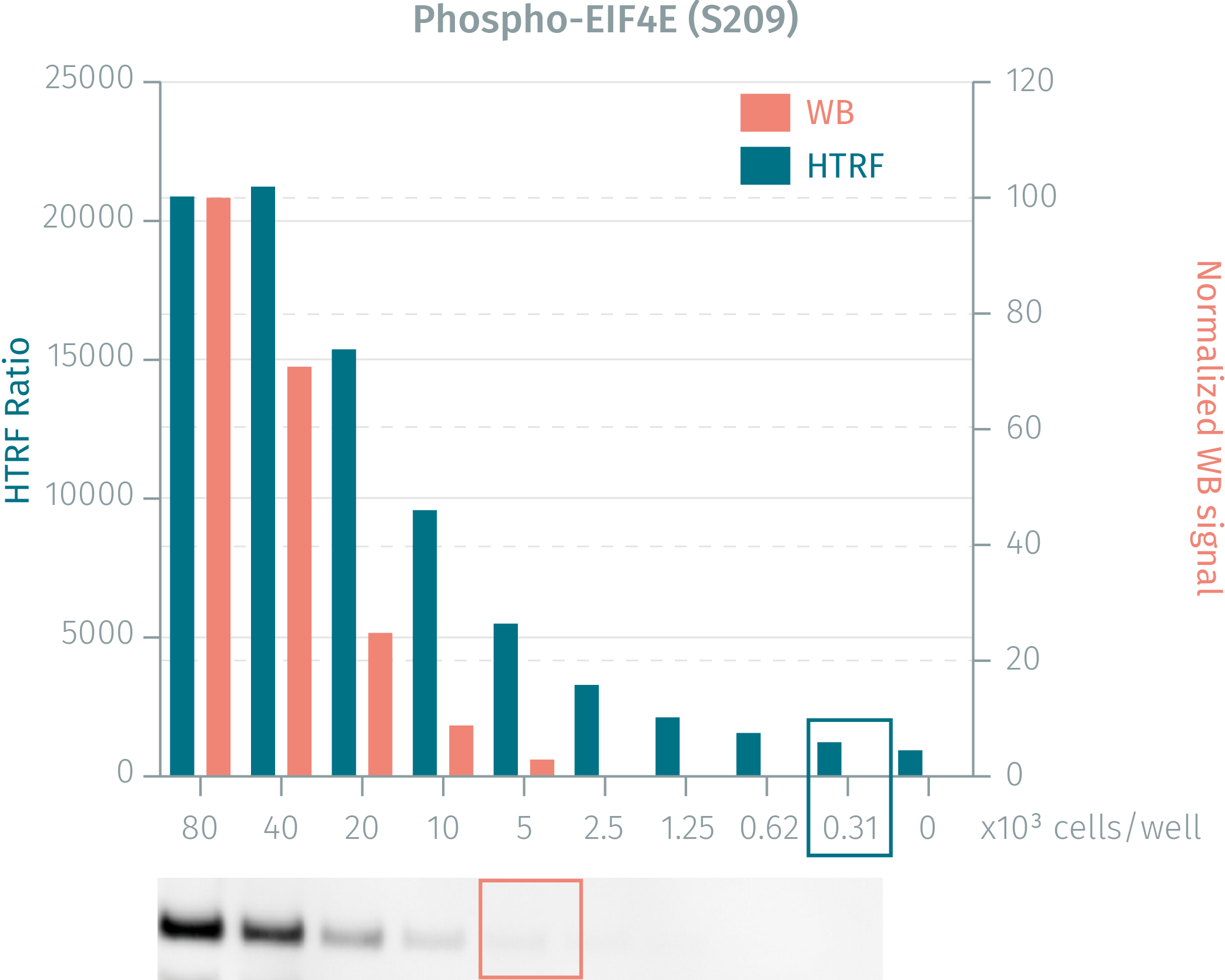

HTRF Human & Mouse Phospho-EIF4E (Ser209) Detection Kit, 500 Assay Points


HTRF Human & Mouse Phospho-EIF4E (Ser209) Detection Kit, 500 Assay Points






The phospho-EIF4E (Ser209) kit enables the cell-based quantification of EIF4E protein phophorylated at Ser209 as a readout of mTor pathway activation.
| Feature | Specification |
|---|---|
| Application | Cell Signaling |
| Sample Volume | 16 µL |
The phospho-EIF4E (Ser209) kit enables the cell-based quantification of EIF4E protein phophorylated at Ser209 as a readout of mTor pathway activation.



HTRF Human & Mouse Phospho-EIF4E (Ser209) Detection Kit, 500 Assay Points



HTRF Human & Mouse Phospho-EIF4E (Ser209) Detection Kit, 500 Assay Points



Product information
Overview
The Phospho-EIF4E (Ser209) cellular assay kit measures endogenous EIF4E protein phosphorylated at Ser209 directly in your cell type of interest. EIF4E enables the expression of key genes involved in cellular proliferation, angiogenesis, and cell survival. EIF4E modulation has applications in metabolism/diabetes, neurosciences and oncology research.
Specifications
| Application |
Cell Signaling
|
|---|---|
| Brand |
HTRF
|
| Detection Modality |
HTRF
|
| Lysis Buffer Compatibility |
Lysis Buffer 1
|
| Molecular Modification |
Phosphorylation
|
| Product Group |
Kit
|
| Sample Volume |
16 µL
|
| Shipping Conditions |
Shipped in Dry Ice
|
| Target Class |
Phosphoproteins
|
| Target Species |
Human
Mouse
|
| Technology |
TR-FRET
|
| Therapeutic Area |
Oncology & Inflammation
|
| Unit Size |
500 Assay Points
|
Video gallery

HTRF Human & Mouse Phospho-EIF4E (Ser209) Detection Kit, 500 Assay Points

HTRF Human & Mouse Phospho-EIF4E (Ser209) Detection Kit, 500 Assay Points

How it works
Phospho-EIF4E (Ser209) assay principle
The Phospho-EIF4E (Ser209) assay measures EIF4E when phosphorylated at Ser209. Contrary to Western Blot, the assay is entirely plate-based and does not require gels, electrophoresis or transfer. The Phospho-EIF4E (Ser209) assay uses 2 labeled antibodies: one with a donor fluorophore, the other one with an acceptor. The first antibody is selected for its specific binding to the phosphorylated motif on the protein, the second for its ability to recognize the protein independent of its phosphorylation state. Protein phosphorylation enables an immune-complex formation involving both labeled antibodies and which brings the donor fluorophore into close proximity to the acceptor, thereby generating a FRET signal. Its intensity is directly proportional to the concentration of phosphorylated protein present in the sample, and provides a means of assessing the proteins phosphorylation state under a no-wash assay format.

Phospho-EIF4E (Ser209) 2-plate assay protocol
The 2 plate protocol involves culturing cells in a 96-well plate before lysis then transferring lysates to a 384-well low volume detection plate before adding phospho-EIF4E (Ser209) HTRF detection reagents. This protocol enables the cells' viability and confluence to be monitored.

Phospho-EIF4E (Ser209) 1-plate assay protocol
Detection of Phosphorylated EIF4E (Ser209) with HTRF reagents can be performed in a single plate used for culturing, stimulation and lysis. No washing steps are required. This HTS designed protocol enables miniaturization while maintaining robust HTRF quality.

Assay validation
Western Blot versus HTRF assay
HEK293 cells were cultured for 1 day in a T175 flask until 80% confluency was reached.. Following lysis and centrifugation, equal amounts of lysates in serial dilutions were analyzed in a side by side comparison of Western Blot and HTRF.. The HTRF assay is determined to be 8-fold more sensitive than Western Blot.

Dose-response of CGP57380 on NIH3T3 cells
Murine NIH3T3 cells (50,000 cells/well) were incubated for 3 hours with various concentrations of CGP57380 inhibitor. After a 30 minutes lysis incubation, inhibition of eIF4E phosphorylation was measured using the HTRF phospho-eIF4E (Ser209) assay with the two-plate protocol.

Dose-response of CGP57380 on stimulated HeLa cells
Human HeLa cells (100,000 cells/well) were incubated with various concentrations of CGP57380 inhibitor, either for 30 minutess or 3 hours, followed by stimulation with 10 µM Anisomycin for 30 minutess at 37°C. After a 30 minutes lysis incubation, inhibition of eIF4E phosphorylation was measured using the HTRF phospho-eIF4E (Ser209) assay with the two-plate protocol.

Simplified pathway
Simplified Pathway for EIF4E
EIF4E, eukaryotic translation initiation factor 4E, initiates eukaryotic protein synthesis by binding to the 5 end of the mRNA cap structure and directing its association with the ribosomes. EIF4E enables the expression of key genes such as cyclins, c-myc, and vascular endothelial growth factor, involved in cell proliferation, angiogenesis and cell survival. Overexpression of phosphorylated eIF4E at Ser209 is associated with tumorgenesis, metastasis, and poor overall survival in several cancers making it a novel research target.

Resources
Are you looking for resources, click on the resource type to explore further.
This guide provides you an overview of HTRF applications in several therapeutic areas.


How can we help you?
We are here to answer your questions.






























